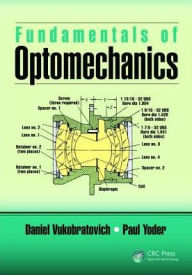Free download audiobook collection Fundamentals of Optomechanics in English 9781498770743 FB2 MOBI
Par barber vincent le lundi, décembre 30 2019, 09:07 - Lien permanent
Fundamentals of Optomechanics. Daniel Vukobratovich, Paul Yoder

Fundamentals-of-Optomechanics.pdf
ISBN: 9781498770743 | 462 pages | 12 Mb

- Fundamentals of Optomechanics
- Daniel Vukobratovich, Paul Yoder
- Page: 462
- Format: pdf, ePub, fb2, mobi
- ISBN: 9781498770743
- Publisher: Taylor & Francis
Free download audiobook collection Fundamentals of Optomechanics in English 9781498770743 FB2 MOBI
Fundamentals of Optomechanics by Daniel Vukobratovich, Paul Yoder This textbook will provide the fundamentals of optomechanics. Starting from the basics, this textbook will lead you through the opto-mechanical design process, discussing materials selection, principles of kinematic design, as well as mounting of windows, individual lenses, and multiple lenses. Techniques for mounting prisms, mirror performance, and design and mounting of mirrors will be included. Written by the two top scientists in the field, this stand-alone, student-friendly textbook has been course-tested and will include homework problems as well as a solutions manual for adopting professors.
Foundations and Applications of Nanomechanics | (smr 3177) (25
fundamental quantum physics and to target the frontiers of quantum mechanics , these systems also have applications in classical and quantum information technology and as ultrasensitive detectors of mass, displacement, acceleration, force or spin. As a result, research directions such as cavity optomechanics and
Fundamentals of Optomechanics | Vukobratovich / Yoder, 2018
This textbook will provide the fundamentals of optomechanics. Starting from the basics, this textbook will lead you through the opto-mechanical design process, discussing materials selection, principles of kinematic design, as well as mounting of windows, individual lenses, and multiple lenses. Techniques for mounting
Optomechanical Enhancement of Doubly Resonant 2D Optical
Emerging two-dimensional semiconductor materials possess a giant second order nonlinear response due to excitonic effects while the monolayer thickness of such active materials limits their use in practical nonlinear devices. Here, we report 3300 times optomechanical enhancement of second harmonic
Fundamentals of optical non-reciprocity based on optomechanical
Abstract: Optical isolation, non-reciprocal phase transmission and topological phases for light based on synthetic gauge fields have been raising significant interest in the recent literature. Cavity-optomechanical systems that involve two optical modes coupled to a common mechanical mode form an ideal
Optomechanical Systems Engineering - Kasunic - Wiley Online Library
This book emphasizes a practical, systems-level overview of optomechanical engineering, showing throughout how the requirements on the optical system flow down to those on the optomechanical design. The author begins with an overview of optical engineering, including optical fundamentals as well
Rev. Mod. Phys. 86, 1391 (2014) - Cavity optomechanics
The field of cavity optomechanics is reviewed. This field explores the interaction between electromagnetic radiation and nanomechanical or micromechanical motion. This review covers the basics of optical cavities and mechanical resonators, their mutual optomechanical interaction mediated by the
OSA | Surface optomechanics: calculating optically excited
Surface optomechanics: calculating optically excited acoustical whispering gallery modes in microspheres. John Zehnpfennig, Gaurav Bahl, Matthew Tomes , and Tal Carmon. Author Information
Optical directional amplification in a three-mode optomechanical
We study the directional amplification of an optical probe field in a three-modeoptomechanical system, where the mechanical resonator interacts with two linearly-coupled optical cavities and the cavities are driven by strong optical pump fields. The optical probe field is injected into one of the cavity modes, and at the same
Motion Basics Terminology & Standards
The function of a linear or rotary stage is to generate a desired motion in an ideal trajectory. Factors like friction between moving parts, quality of guides or bending induced by moving loads ,often deviate the motion from this ideal trajectory. High performance motion systems are complex, so overlooking a seemingly small
Fundamentals of Optomechanics (Optical Sciences - Amazon.com
Buy Fundamentals of Optomechanics (Optical Sciences and Applications of Light ) on Amazon.com ✓ FREE SHIPPING on qualified orders.
Conferences | K-Lab - K-LAB | EPFL
CLEO, San Fransisco, USA, 5th to 10th June 2016. "Cavity Optomechanics:Fundamentals and Applications of Controlling and Measuring Nano- and Micro- mechanical Oscillators with Laser Light", Invited Talk. T.J. Kippenberg. "Raman Self-frequency shift of Dissipative Kerr Solitons in an Optical Microresonator". H.R. Guo
Ultrahigh-Q optomechanical crystal cavities fabricated in a - Nature
This optomechanical interaction has been used not only to study thefundamentals of quantum interaction between light and matter but also to develop devices for applications, such as RF-memories, accelerometers, torque sensors and synchronization of mechanical oscillators. However, most of these
wombat program - Cudos
Sydney, Australia · 21-22 July 2015 · The University of Sydney · Camperdown, Sydney, Australia · 20 July 2015. INVItEd PrEsENtatIoNs. KEYNotE addrEss. tutorIaLs. INdustrY ENgagEmENt. NEtworKINg oPPortuNItIEs. Workshop onOptoMechanics and Brillouin scattering: fundamentals, Applications and Technologies
Fundamentals of Optomechanics - CRC Press Book
This textbook will provide the fundamentals of optomechanics. Starting from the basics, this textbook will lead you through the opto-mechanical design process, discussing materials selection, principles of kinematic design, as well as mounting of windows, individual lenses, and multiple lenses. Techniques for mounting